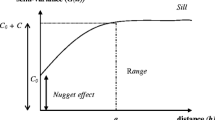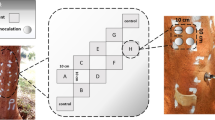Abstract
The relative importance of Pseudocercospora macadamiae conidia produced from the subepidermal stromata of diseased husk and the effect of climatic factors on husk spot epidemics were assessed on managed (fungicide-protected) and unmanaged macadamia trees. The spatial pattern of diseased fruit in the tree canopy was quantified using the binary form of Taylor’s power law on 54 trees for 4 years. The a and b parameters of the power law showed year-to-year variations in the unmanaged epidemic. This was attributed to differences in climatic conditions and the amount of early infection in the tree canopy. Overall, diseased fruit aggregated, heterogeneity was in excess of the levels expected for a random pattern (a >1; b >1), and the degree of aggregation increased with the incidence mean. The rate of increase in disease incidence was significantly lower in the managed rather than the unmanaged epidemic. However, the rates of increase of disease severity were comparable, suggesting that other factors contribute to abscission of diseased fruit. The effect of each climatic factor examined on disease severity was <50%. The number of rainy days (R 2 = 74%) was the single-most important factor influencing disease incidence. The results indicate that P. macadamiae conidia are mostly rain-splash dispersed, thus proximity of new fruit to the source of inoculum (diseased husk) significantly influences disease incidence. Practical implications for effective husk spot control are discussed.
Similar content being viewed by others
References
Akinsanmi OA, Miles AK, Drenth A (2007) Timing of fungicide application for control of husk spot caused by Pseudocercospora macadamiae in macadamia. Plant Disease 91, 1675–1681. doi: 10.1094/PDIS-91-12-1675
Akinsanmi OA, Miles AK, Drenth A (2008) Alternative fungicides for controlling husk spot caused by Pseudocercospora macadamiae in macadamia. Australasian Plant Pathology 37, 141–147. doi: 10.1071/ AP08001
Beilharz V, Mayers PE, Pascoe IG (2003) Pseudocercospora macadamiae sp. nov., the cause of husk spot of macadamia. Australasian Plant Pathology 32, 279–282. doi: 10.1071/AP03018
Elmer PAG, Gaunt RE, Frampton CM (1998) Spatial and temporal characteristics of dicarboximide-resistant strains of Monilinia fructicola and brown rot incidence in stone fruit. Plant Pathology 47, 530–536. doi: 10.1046/j.1365-3059.1998.00266.x
Fitt BDL, McCartney HA, Walklate PJ (1989) The role of rain in dispersal of pathogen inoculum. Annual Review of Phytopathology 27, 241–270. doi: 10.1146/annurev.py.27.090189.001325
Hughes G, Madden LV (1992) Aggregation and incidence of disease. Plant Pathology 41, 657–660. doi: 10.1111/j.1365-3059.1992. tb02549.x
Kocks CG, Zadoks JC, Ruissen MA (1999) Spatio-temporal development of black rot (X. campestris pv. campestris) in cabbage in relation to initial inoculum levels in field plots in The Netherlands. Plant Pathology 48, 176–188. doi: 10.1046/j.1365-3059.1999.00320.x
Madden LV, Hughes G (1995) Plant disease incidence: distributions, heterogeneity and temporal analysis. Annual Review of Phytopathology 33, 529–564. doi: 10.1146/annurev.py.33.090195.002525
Mayers PE (1998) Epidemiology and control of husk spot of macadamia. Australian Macadamia Society Ltd News Bulletin, Lismore, Australia, pp. 59–64. ISSN 0811-3475
McCartney HA, Fitt BDL (1998) Dispersal of foliar fungal plant pathogens: mechanisms, gradients and spatial patterns. In ‘The epidemiology of plant diseases’. (Ed. DG Jones) pp. 138–160. (Kluwer Publishers: Dordrecht, The Netherlands)
Meredith DS (1970) ‘Banana leaf spot disease (Sigatoka) caused by Mycosphaerella musicola Leach.’ (Commonwealth Agricultural Bureaux: Kew, UK) 147 pp.
Mila AL, Driever GF, Morgan DP, Michailides TJ (2005) Effects of latent infection, temperature, precipitation, and irrigation on panicle and shoot blight of pistachio in California. Phytopathology 95, 926–932. doi: 10.1094/PHYTO-95-0926
Miles AK, Akinsanmi OA, Sutherland PW, Aitken EAB, Drenth A (2009) Infection, colonisation and sporulation by Pseudocercospora macadamiae on macadamia fruit. Australasian Plant Pathology 38, 36–43. doi: 10.1071/AP08074
Mourichon X, Fullerton RA (1990) Geographical distribution of the two species Mycosphaerella musicola Leach (Cercospora musae) and M. fijiensis Morelet (C. fijiensis), respectively agents of Sigatoka disease and Black Leaf Streak disease in bananas and plantains. Fruits 45, 213–218.
Nagao MA, Sakai WS (1985) Effects of growth regulators on abscission of young macadamia fruit. Journal of the American Society for Horticultural Science 110, 654–657.
Peres NAR, Souza NL, Zitko SE, Timmer LW (2002) Activity of benomyl for control of postbloom fruit drop of citrus caused by Colletotrichum acutatum. Plant Disease 86, 620–624. doi: 10.1094/PDIS.2002.86.6.620
Richardson AC, Dawson TE (1993) Enhancing abscission of mature macadamia nuts with ethephon. New Zealand Journal of Crop and Horticultural Science 21, 325–329.
Sakai WS, Mike AN (1985) Fruit growth and abscission in Macadamia integrifolia. Physiologia Plantarum 64, 455–460. doi: 10.1111/j.1399-3054.1985.tb08522.x
Sakai WS, Nagao MA (1985) Fruit growth and abscission in Macadamia integrifolia. Physiologia Plantarum 64, 455–460. doi: 10.1111/j.1399-3054.1985.tb08522.x
Scherm H, Savelle AT, Boozer RT, Foshee WG (2008) Seasonal dynamics of conidial production potential of Fusicladium carpophilum on twig lesions in southeastern peach orchards. Plant Disease 92, 47–50. doi: 10.1094/PDIS-92-1-0047
Schuh W (1990) Influence of tillage systems on the disease intensity and spatial pattern of Septoria leaf blotch. Phytopathology 80, 1337–1340. doi: 10.1094/Phyto-80-1337
Shaw MW, Royle DJ (1989) Airborne inoculum as a major source of Septoria tritici (Mycosphaerella graminicola) infections in winter wheat crops in the UK. Plant Pathology 38, 35–43. doi: 10.1111/ j.1365-3059.1989.tb01425.x
Sposito MB, Amorim L, Bassanezi RB, Filho AB, Hau B (2008) Spatial pattern of black spot incidence within citrus trees related to disease severity and pathogen dispersal. Plant Pathology 57, 103–108.
Stephenson RA, Gallagher EC (1987) Effects of temperature, tree water status and relative humidity on premature nut drop from macadamia. Scientia Horticulturae 33, 113–121. doi: 10.1016/0304-4238(87) 90037-9
Stover RH (1962) Intercontinental spread of the banana leaf spot (Mycosphaerella musicola Leach). Tropical Agriculture (Trinidad) 39, 327–337.
Suffert F, Delalande D, Prunier M, Andrivon D(2008) Modulation of primary and secondary infections in epidemics of carrot cavity spot through agronomic management practices. Plant Pathology 57, 109–121.
Taylor LR (1961) Aggregation, variance and the mean. Nature 189, 732–735. doi: 10.1038/189732a0
Timmer LW, Darhower HM, Zitko SE, Peever TL, Ibanez AM, Bushong PM (2000) Environmental factors affecting the severity of Alternaria brown spot of citrus and their potential use in timing fungicide applications. Plant Disease 84, 638–643. doi: 10.1094/PDIS.2000.84.6.638
Trueman SJ, Turnbull CGN (1994) Fruit set, abscission and dry-matter accumulation on girdled branches of macadamia. Annals of Botany 74, 667–674. doi: 10.1006/anbo.1994.1169
Trueman SJ, Richards S, McConchie CA, Turnbull CGN (2000) Relationships between kernel oil content, fruit removal force and abscission in macadamia. Australian Journal of Experimental Agriculture 40, 859–866. doi: 10.1071/EA00004
van Leeuwen GCM, Stein A, Holb I, Jeger MJ (2000) Yield loss in apple caused by Monilinia fructigena (Aderh. & Ruhl.) Honey, and spatio-temporal dynamics of disease development. European Journal of Plant Pathology 106, 519–528. doi: 10.1023/A:1008701315200
Waggoner PE, Rich S (1981) Lesion distribution, multiple infection, and logistic increase of plant disease. Proceedings of the National Academy of Sciences of the United States of America 78, 3292–3295. doi: 10.1073/ pnas.78.6.3292
Xu XM, Robinson JD, Berrie AM, Harris DC (2001) Spatio-temporal dynamics of brown rot (Monilinia fructigena) on apple and pear. Plant Pathology 50, 569–578. doi: 10.1046/j.1365-3059.2001.00602.x
Author information
Authors and Affiliations
Corresponding author
Rights and permissions
About this article
Cite this article
Akinsanmi, O.A., Drenth, A. Spatial pattern and the effects of climatic factors on husk spot disease in macadamia. Australasian Plant Pathol. 39, 125–131 (2010). https://doi.org/10.1071/AP09071
Received:
Accepted:
Issue Date:
DOI: https://doi.org/10.1071/AP09071




